DSC03086
:w;Tv Distribuiion in j Fluid
Find tr»c anilinie u' w huh the pressure deviation is (u) I tvrv*n: and <ó! 5 pcreent. What do you conclude?
Put ?n>b. 2.2t* on an analnie basis by assuming arbiirary B 1:1 |2.27). Show that. appro\immely. the deviution in
pressure is less than I percent of ptł if ; < 0.14To/fl. Eanh”s atmosphcric corditions vary somewhat. On a certain G2> the sea-leve! temperaturę is 45°F. and the sea-level presje is 29.5 inHg. An airplane oserhcad register* an air temperaturę of 1S°F and a prcssure of 12 lbf/in:. Estimate the plane's altitude. in ft.
Under some condirions the atmosphere is adiabatic, p ■* (constKp*). where k is the specific-heat ratio. Show that. for an adiabatic atmosphere. the prcssure variation is given by
it/tt-n ■
u - i)gz
P = Po
kRT,
o
Compare this formula for air at c = 10.000 m with the standard atmosphere in Table A.6.
In Fig. P2.30 fluid I is SAE 30 oil. and fluid 2 is carbon tetrachloride. If pa - 99 kPa. determine the absolute pres-surc at point A.

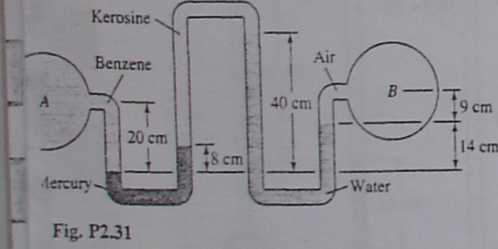
H For the inverted manometer of Fig. P2.32, all fluids are at 20°C. If pB — pA = 97 kPa, what must the height H be in
L cm?

Meriam red oil.
SG-O.S27 N
Waler

18 cm
H
35 cm
Mercury

Fig. P2J2
233 In Fig. P2.33 the prcssure at point A is 25 lbf/in2. All fluids are at 20°C. What is the air prcssure in the closed chambcr B. in Pa?
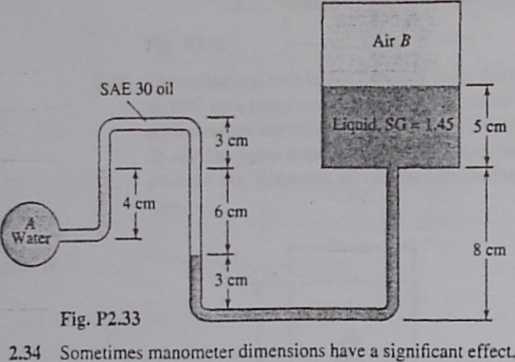
In Fig. P2.34 containers (a) and (b) are cylindrical and con-
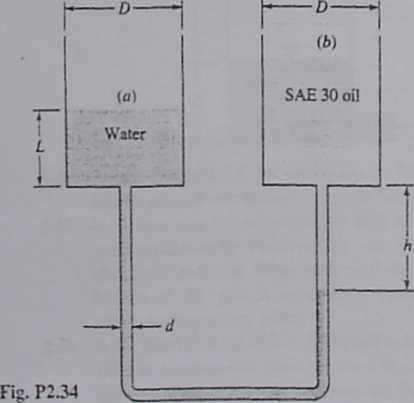

nn
ditions arc such that p„ = ph. Derive a formuła for the pressure difference pa — pb when the oil-water interface on the right rises a distance A/i < h. for (a) d < O and (b) d — 0.2D. What is the percentage change in the value of Ap?
235 For a specific application of Ptrob. 2.34, take D = 5 cm, L = 8 cm, and h = 10 cm. Both fluids are at 20°C. Evaluate Pa ~ Pb when A/i = 1 cm for (a) d 0 and (b) d = 1 cm.
236 For Fig. 2.9 in the texl. let fluid 1 be water and fluid 2 be mercury, at 20°C. The right leg is fined with a scalę to read pA in kPa (gage). What should the length between scalę graduations be, in mm?
237 The inclined manometer in Fig. 2.37 contains Meriam red manometer oil, SG = 0.827. Assume that the reservoir is very larg^If the inclined arm is fltted with graduations 1 in apart, what should the angle 6 be if each graduation corre-sponds to 1 Ibf/ft2 gage pressure for p/!
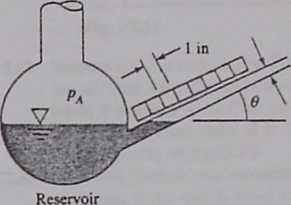
Fig. P237
238 Repeat Prób. 2.37 for a finite reservoir approximating a half-full hemisphere with a diameter of 6 in.
239 An 8-cm-diameter piston compresscs manometer oil into an inclined 7-mm-diameter tubę, as shown in Fig. P2.39. When a weight W is added to the top of the piston, the oil rises an additional distance of 10 cm up the tubę. as shown. How large is the weight, in N?
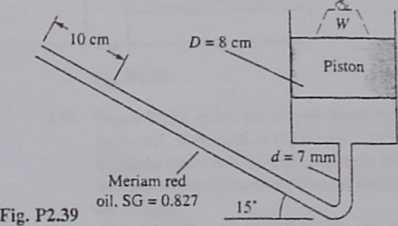
2.40 A pump slowly introduces mercury into the bottom of the closed tank in Fig. P2.40. At the instant shown. the air pressure pB = 80 kPa. The pump stops when the air pressure
rises to 110 kPa. All fluids remain at 20°C. What will bc the manometer reading h at that urnę. in cm. if it is connected to standard sea-level ambient air pnm?
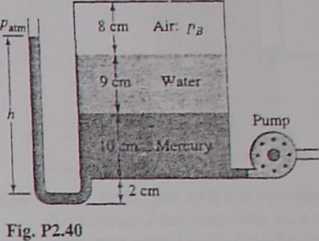
2.41 The system in Fig. P2.41 is at 20°G. Compute the pressure at point A in lbf/ft2 absolute.
Water
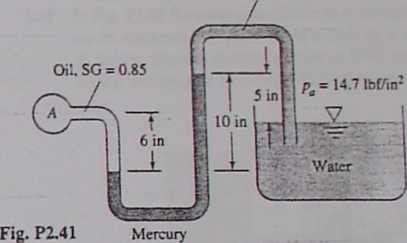
2.42 Very smali pressure differences pA — pB can be measured accurately by the two-fluid differential manometer in Fig. P2.42. Density pj is only slightly larger than that of the upper fluid p,. Derive an expression for the proportionality between h and pA — pB if the reservoirs are very large.

Wyszukiwarka
Podobne podstrony:
DSC03088 .« Pirssure Distribution in a Fluid 2.-U)>. What diameter of the sphere is just sufficie
DSC03090 ‘*ł Pressure Distribuooo in a Fluid Fig. P2.99 atmospherfc pressure. compute the hydrostati
DSC03089 PresMłrt DisłnNjocc in a Fluid Fig. P2JS4 atmospberic pressure, and let tbe surfacc hm unit
DSC03091 * jrr Distnbutioo in a Fluid 3.1* 10cm 5 cm i Comptue the ńetd-body rotadon ratę about its
photos. In many remote parts of the country this is expensive and time consuming and most of the wor
DSCI9896 28($ which rcąuire morc muscular energy in their produclion, c) which are produccd whcn the
18 In both cases a regular employment contract for the subsidized person is reąuired. This is not th
34986 img017 Introduction The Swiss Bali is a familiar and inexpensive piece of eąuipment found in m
DSC03085 30 Pressure Distriburion in a FluidI ■ • ■■■■■■■Mm e 2.13 in Fig. P2.13
DSC03087 & . II-I. i.. — Xj Pressure Dismbution in a Fluid 1
f2 5 Find In Files Find what: 1 Find
f2 6 Find In Files a Find whal: Find 1 n files of lype: x.c;x. cpp;x. cxx;x. h zl Cancel In fol
f20 1 Find In Files a Find what: MBBMI ^
38. Musioł D.: Poly-optimization as a metod for calculation o fair distribution In
więcej podobnych podstron